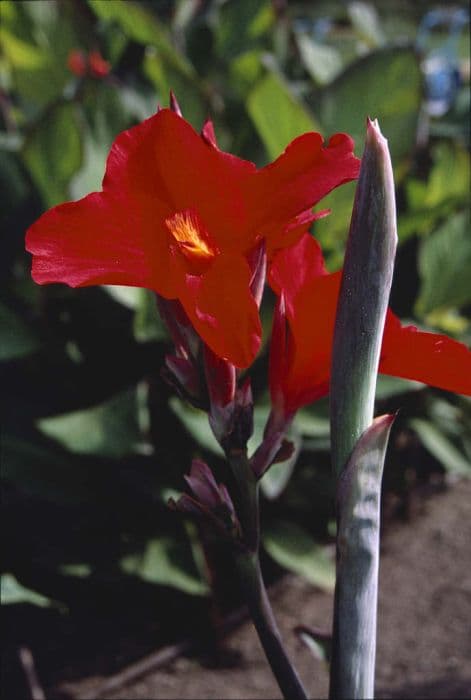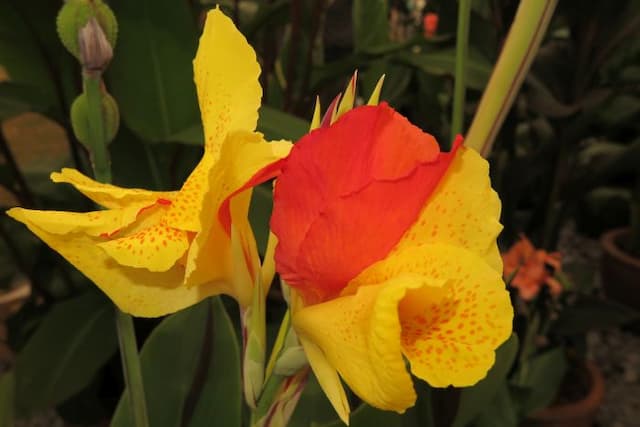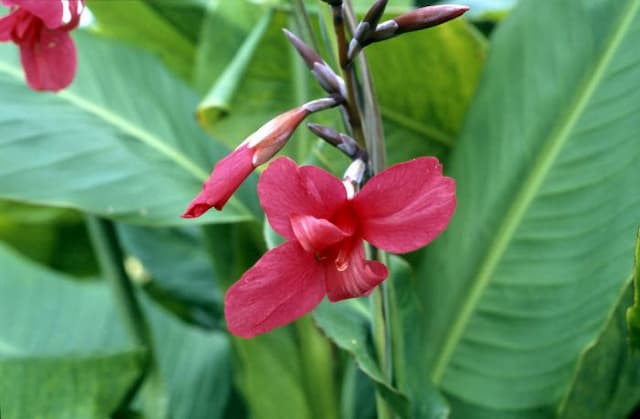Canna Lily Canna 'E. Neubert'

ABOUT
Canna 'E. Neubert' is a striking plant with a bold and vibrant appearance. Often referred to as Canna Lily, despite not being a true lily, this variety boasts broad, banana-like leaves that are a lush green, sometimes with a hint of bronze or maroon. The foliage itself creates a lush backdrop for the truly eye-catching feature of the plant: its flowers. The flowers of Canna 'E. Neubert' present an exotic look, reminiscent of orchids, and come in a shade that could be described as a deep, luscious crimson or a bright scarlet, depending on the light. Each petal is smooth and almost waxy to the touch, and they tend to have a gently ruffled edge that adds to the ornamental appeal. The blossoms are typically arranged in a spike-like inflorescence, rising boldly above the foliage, showcasing their ornate and arresting visual interest. While Canna Lilies are known to vary in size, the visual effect that Canna 'E. Neubert' creates is one of tropical elegance and robust beauty, making it a standout plant in any garden where it can create a dramatic visual focus. The vibrant, showy blooms, combined with the substantial leafy presence of its foliage, ensure that this plant makes a substantial aesthetic impact regardless of its specific measurements.
About this plant
 Names
NamesFamily
Cannaceae.
Synonyms
Indian Shot, Canna Lily, Canna.
Common names
Canna 'E. Neubert'
 Toxicity
ToxicityTo humans
Canna 'E. Neubert', or more commonly known as Canna Lily, is not considered toxic to humans. There are no significant toxic effects reported for humans upon ingesting any parts of this plant. It is generally recognized as safe, and there are no well-documented cases of poisoning from this plant. Therefore, accidental ingestion is unlikely to cause any serious symptoms or consequences.
To pets
Canna Lily is not known to be toxic to pets, including cats and dogs. It does not appear on lists of poisonous plants for pets provided by organizations such as the ASPCA (American Society for the Prevention of Cruelty to Animals). Therefore, if a pet were to ingest part of a Canna Lily, no specific symptoms of poisoning are expected, and it should not cause any significant health consequences for the animal. However, ingestion of large amounts of plant material by pets could potentially lead to general gastrointestinal upset, like any non-food item might.
 Characteristics
CharacteristicsLife cycle
Perennials
Foliage type
Deciduous
Color of leaves
Green
Flower color
Mixed
Height
4-6 feet (1.2-1.8 meters)
Spread
1-2 feet (0.3-0.6 meters)
Plant type
Bulb
Hardiness zones
7-10
Native area
South America
Benefits
 General Benefits
General Benefits- Aesthetic Appeal: Canna 'E. Neubert' adds striking visual interest to gardens with its vibrant flowers and lush foliage.
- Low Maintenance: It requires minimal care once established, making it a convenient choice for gardeners of all skill levels.
- Attracts Pollinators: The flowers of the Canna Lily attract bees, butterflies, and hummingbirds, supporting local ecosystems.
- Drought Tolerance: Once established, it can tolerate periods of low water, which is beneficial in water-restricted areas.
- Fast Growth: The Canna Lily grows quickly, filling up garden spaces and providing immediate gratification in landscape designs.
- Versatile Landscaping: Suitable for beds, borders, and containers, it offers versatility in garden and landscape design.
- Season-Long Bloom: The blooming season of the Canna Lily extends throughout the summer and sometimes into fall.
- Deer Resistance: Canna Lilies are not preferred by deer, which helps prevent damage in areas where deer browse gardens.
 Medical Properties
Medical PropertiesThis plant is not used for medical purposes.
 Air-purifying Qualities
Air-purifying QualitiesThis plant is not specifically known for air purifying qualities.
 Other Uses
Other Uses- Canna 'E. Neubert', commonly known as canna lily, can be utilized as a natural pest deterrent due to certain compounds in the plant that repel harmful insects from gardens.
- The large leaves of the canna lily can be used as natural wrapping materials for small parcels or as eco-friendly food wraps in place of plastic.
- Canna lily's leaves are sometimes used as a green dye source for natural fabric coloring processes, imparting a subtle color to textiles.
- In some cultures, the starchy rhizomes of the canna lily are used for making flour or as a thickening agent in cooking.
- The seeds of the canna lily are hard and can be polished and used in jewelry making or as beads in decorative crafts.
- The fibrous nature of canna lily's stems and leaves allows them to be processed and woven into bio-based composites or materials for sustainable product design.
- Canna lily plants can be strategically placed in landscapes to act as natural barriers or to define borders due to their dense foliage.
- Dried canna lily leaves can be incorporated into hand-made paper to add texture and visual interest in the art of papermaking.
- Dried flowers of the canna lily can be used in potpourri mixtures to impart a subtle fragrance and add a splash of color to the mix.
- The hollow stems of canna lilies, once dried, can be used to create lightweight, natural flutes or other musical instruments in some artisan crafts.
Interesting Facts
 Feng Shui
Feng ShuiThe Canna Lily is not used in Feng Shui practice.
 Zodiac Sign Compitability
Zodiac Sign CompitabilityThe Canna Lily is not used in astrology practice.
 Plant Symbolism
Plant Symbolism- Passion: Cannas, with their vibrant colors and bold presence, are often associated with intense emotions and a spirited nature, symbolizing a lively and passionate personality.
- Creativity: The striking and unusual flowers of the Canna represent creativity and an artistic spirit, inspiring individuals to embrace innovation and imaginative thinking.
- Confidence: The sturdy and upright growth habit of the Canna plant conveys confidence and pride, encouraging people to stand tall and assert themselves in various situations.
- Change and Transition: Since Cannas are perennial and re-emerge every year, they symbolize the concept of renewal and the ability to navigate through changes and transitions in life.
 Water
WaterCanna Lilies, like the Canna 'E. Neubert', should be watered thoroughly and deeply to encourage deep root growth. During active growth in the hotter months, water your Canna Lily with about 1 to 1.5 gallons of water per week, depending on the weather conditions. If it rains, you may need to water less. It is important to maintain consistently moist soil, but not waterlogged, as Canna Lilies do not like to be in dry soil for prolonged periods. Over the winter months when the plant is dormant, reduce watering significantly to prevent rot.
 Light
LightCanna Lilies prefer a spot where they can receive full sun for at least 6 to 8 hours a day. They thrive in bright light conditions and are tolerant to partial shade, but flowering may not be as abundant. Place your Canna 'E. Neubert' in an area where it can get uninterrupted sunlight to promote vigorous growth and vibrant flowers.
 Temperature
TemperatureCanna Lilies are tropical plants and prefer temperatures between 60°F and 90°F. They can tolerate a minimum temperature down to 55°F; however, they should be protected from frost. If temperatures drop below this range, it is recommended to lift the rhizomes and store them indoors during the winter. The ideal growing temperature for Canna 'E. Neubert' is in the mid-70s°F to ensure optimal growth.
 Pruning
PruningPruning Canna Lilies is done to remove old flowers and leaves, which encourages new growth and improves air circulation. Prune the Canna 'E. Neubert' after flowering by cutting the spent flower stalks down to the next side shoot. Remove dead or damaged leaves as needed. The best time to prune heavily is in late winter or early spring before new growth begins.
 Cleaning
CleaningAs needed
 Soil
SoilCanna Lily 'E. Neubert' requires well-draining, rich soil with a pH of 6.0 to 6.5. An ideal soil mix is two parts garden soil, one part compost or well-rotted manure, and one part sand or perlite for aeration.
 Repotting
RepottingCanna Lilies should be repotted every 2 to 3 years to refresh the soil and accommodate root growth; divide rhizomes in spring before new growth starts.
 Humidity & Misting
Humidity & MistingCanna Lily 'E. Neubert' tolerates average outdoor humidity levels well but doesn't require excessively high humidity to thrive.
 Suitable locations
Suitable locationsIndoor
Ensure ample light, warm temps, and good soil.
Outdoor
Plant in full sun, rich soil, and water regularly.
Hardiness zone
7-11 USDA
 Life cycle
Life cycleCanna 'E. Neubert' begins its life cycle when a rhizome (underground stem) is planted in the soil in spring after the last frost; this rhizome will sprout shoots that develop into large, paddle-shaped leaves. The shoots rapidly grow into tall stalks, and within a few weeks, the plant starts producing vibrant blooms, usually in the summer months, which can be a variety of colors including red, orange, or yellow. After pollination, typically by insects, the flowers will fade and seed pods may form, containing seeds that can be collected and planted or allowed to drop and potentially germinate nearby. In regions with a winter season, the foliage dies back after the first frost, and the rhizomes enter a period of dormancy. Gardeners in colder climates often lift and store the rhizomes indoors during the winter to protect them from freezing. With the return of warm weather in the following spring, the cycle begins anew as the rhizomes can be replanted to regenerate the plant.
 Propogation
PropogationPropogation time
Spring-Early Summer
Propogation: The Canna Lily 'E. Neubert', a vibrant perennial known for its showy flowers and foliage, is typically propagated during late winter or early spring before the onset of the growing season. The most popular method of propagation for the Canna Lily is through dividing its rhizomes. To propagate, carefully dig up the clumps of Canna after the foliage has died back or before new growth begins. Using a sharp knife, divide the rhizomes into sections ensuring each piece has at least one eye or bud. Trim any excessively long roots and damaged sections. Replant the rhizome sections immediately at a depth of 3 to 4 inches (about 7.5 to 10 centimeters) in well-draining soil, making sure the eyes are facing upwards. Water the newly planted rhizomes thoroughly to encourage the growth of new shoots.









